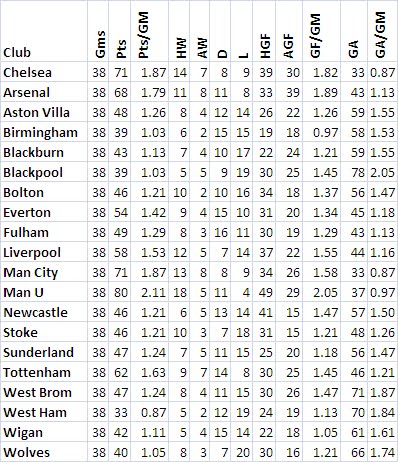It is already the stuff of legend: Last night's miraculous 95th-minute goal by Jonathan Bornstein on a beautiful corner kick by the Crew's Robbie Rogers to tie Costa Rica sent the Ticos into the last-chance playoff against Uraguay for the final World Cup spot in the Western Hemisphere and gave the U.S. yet another CONCACAF Champtionship.
It seemed highly unlikely. And in fact it was.
 As a review of an intriguing statistical study from the UK as well as recent EPL and MLS stats show, the chances that a team will score directly off a corner kick are slim-to-none:
As a review of an intriguing statistical study from the UK as well as recent EPL and MLS stats show, the chances that a team will score directly off a corner kick are slim-to-none:
“It has been suggested that over 40% of goals in soccer are scored from set-pieces (Hughes, 1999) and that goals from this source are important at all levels of the game (Bate, 1988). Jinshan et al. (1993), for example, found that setpieces accounted for between 27 percent and 32 percent of goals in the 1986 and 1990 Soccer World Cups respectively, while Grant et al. (1999) reported a figure of 24.65 at the 1998 tournament. Among set pieces, free kicks and corner kicks have been shown to be the greatest source of goals, producing 46 percent and 132 percent of goals respectively at the 1994 World Cup (Sousa and Graganta, 2001) and 50 percent and 47.6 percent at the 1998 Competition (Grant et al.,1999).”
So, set-pieces are important. However, the same article reports that in one study, only 31 percent of corners resulted in a shot on goal. Of those SOGs, only 8 percent were then successfully converted into goals. This means that in one study at least, only 2.4 percent of corner kicks resulted directly in goals. Interestingly, however, a full 10 percent of all goals scored in the matches studied came from corners. This tells us just how important working on set pieces, especially corners, is to a team’s overall success. If you don’t take such opportunities seriously, your overall production of goals for the season is going to suffer. And in leagues where only a few pts separate teams, resulting in relegation, promotion, a shot at the playoffs (which are stupid) or a European tour in either the UEFA Champions league or Europa, 10 percent is significant.
What’s the tactical key to success? Ask Robbie Rogers and Jonathan Borenstein. The same study found that if you hit an in-swinger that accurately targets a specific zone in front of the goal, right about the PK spot running from edge to edge of the goal box, then your chance of turning a CK into a Shot on Goal goes up to 40 percent. And given that about 27 percent of all SOGs end up as actual Goals, you’ve now turned a CK into a rather dangerous weapon. Last night's dramatic goal was scored on an inswinging corner kick that landed smack dab in the middle of the zone described in the study. That the ultimate percentage of CKs to Gs is still only around 3 percent means that being able to hit that inswinger, and put it on the top of the goal box time after time is rather difficult for even the pros in the EPL and the MLS let alone your kid on Saturday morning. Plus, notice that on average, around 25 percent of SOGs become goals, but only around 8 percent of SOGs created by a corner kick become goals. This tells you how much harder it is to score a goal on an SOG created by a corner kick rather than all the other ways SOGs get created.
In short, individual corners are relatively innocent affairs. But the more corners you earn, the greater the chance that you’ll put the ball into the back of the net, right? Yes, but only if your team is good at set pieces. Read on.
A review of EPL and MLS data by El Chupa has revealed that the relationship between the sheer number of corners you earn and goals scored is not linear. The very best teams earn a lot of corners and score more goals than the very worst teams. But for average teams, the more corners you take doesn't necessarily result in more goals. That's because some teams are better at set pieces than others. When looking at corner kicks as a measure of an average team’s production, then, one also has to take into consideration the RATE at which a particular team turns CKs into SOGs and ultimately into Goals. Such data, alas, is virtually impossible to come by. The teams obviously keep track of it, but El Chupa is yet to find it on the intrawebs—probably because teams don’t want other teams to know their strengths and weaknesses. Interestingly, the correlation between Corners and Goals Scored is stronger in the EPL than in the MLS. We're still trying to figure that one out. We'll let you know if we learn anything.
the very worst teams. But for average teams, the more corners you take doesn't necessarily result in more goals. That's because some teams are better at set pieces than others. When looking at corner kicks as a measure of an average team’s production, then, one also has to take into consideration the RATE at which a particular team turns CKs into SOGs and ultimately into Goals. Such data, alas, is virtually impossible to come by. The teams obviously keep track of it, but El Chupa is yet to find it on the intrawebs—probably because teams don’t want other teams to know their strengths and weaknesses. Interestingly, the correlation between Corners and Goals Scored is stronger in the EPL than in the MLS. We're still trying to figure that one out. We'll let you know if we learn anything.
Does this mean that CKs and CKAs aren’t a useful statistic? No, clearly, if your team is earning corners at a higher rate than the opposition, then you’re putting more pressure on their goal than they are on yours. Over time, this is an indication of how good you are at creating scoring chances, and how good you are at preventing the other team from creating scoring chances against you. The Luchametric doesn’t weight CKs and CKAs as much as goals obviously, but we do include them in the metric.
But when we’re on the couch, a powerful IPA or porter in hand, and our beloved Black and Gold are preparing to defend a CK by the beer foam from the Great-White-Trash-North, we breath easy. . . and crack another brew. Do it.









 The Luchametric is a
The Luchametric is a 


















No comments:
Post a Comment